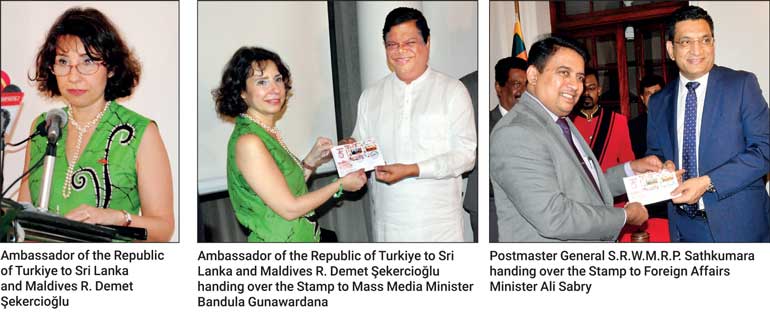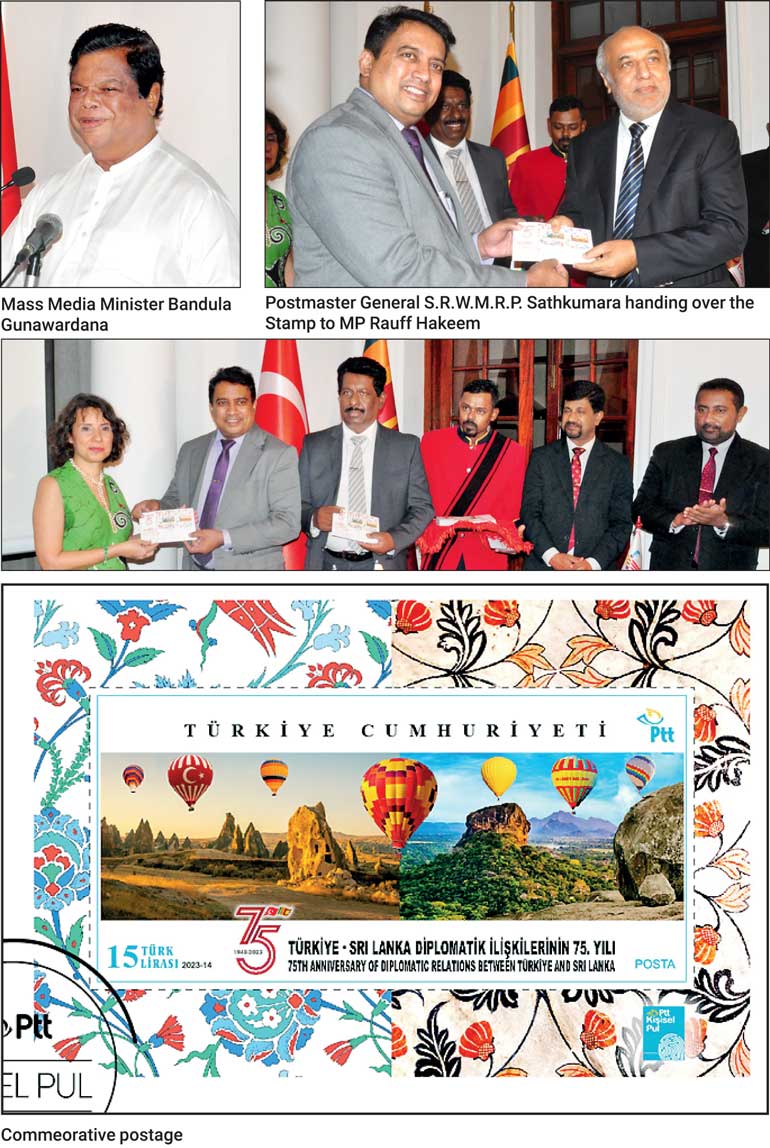Friday Apr 11, 2025
Friday Apr 11, 2025
Saturday, 9 December 2023 00:06 - - {{hitsCtrl.values.hits}}

I’m indeed honoured to stand before you today at this significant event, marking yet another milestone in our cordial bilateral relations.
As we have almost reached the end of 2023, I would like to start by emphasising the significance of the year we just passed, not only to Türkiye but also to our profound relations between Türkiye and Sri Lanka.
The significance of year 2023 reverberates beyond the centenary proclamation of the Turkish Republic. We also commemorate the 75th anniversary of the establishment of diplomatic relations between our Republics.
It is worth mentioning that Türkiye was among the first countries to recognise Sri Lanka’s independence 75 years ago. Our relation gained a new dimension with the establishment of our Embassy here in Colombo 10 years ago, indeed serving as a true testament to our growing and flourishing partnership.
However, I must say that our shared history goes far beyond 75 years, with an ancient relationship dating back to the time of the Ottoman Empire.
The Muslims in Sri Lanka who maintained close relations with the Ottomans during the British colonial era, have played a crucial role in this connection. Their devotion to the Ottoman Empire and contributions to the Muslim society were recognised with prestigious appointments of Shah-benders (Consuls)/Honorary Consuls to the Island by the Ottoman Sultans themselves.
Therefore, we are here today to celebrate this enduring relationship with the issuance of a special commemorative postage stamp on the occasion of the celebration of the 75th anniversary of diplomatic relations between Sri Lanka and Türkiye.

As much as our deep-rooted connections, the design and decorations on the sides of this stamp features the iconic regions of Cappadocia in Türkiye and Sigiriya in Sri Lanka symbolising our intertwined histories.
I must say that both are renowned for their unique geographical structures and rich heritage, making them prominent tourist destinations.
I would like to shortly highlight the history behind the scenic beauty of Cappadocia, which might not be known to everyone in Sri Lanka.
Cappadocia is a region in Central Anatolia, Türkiye, where nature and history merge. It is best known for its unique geological features called fairy chimneys, underground cities, cave churches.
About 30 million years ago, in what is now central Türkiye, volcanoes spewed ash over the landscape. Eventually, the ash solidified into rock, called tuff, tens of meters thick. In the millions of years that followed, wind and water eroded the tuff into odd shapes, including spires, cones, even a camel.
In more recent times, a different force went to work on the rocks of this region. The tuff was soft and easily worked, and people made this place home, hollowing out the rocks, and carving windows, doors, and curving stairways. Locals even carved churches into the rock.
Cappadocia, sculpted out of the tuff of Mount Erciyes and Mount Hasan through millions of years by sand and water erosion, became the seat of several civilisations, and a silent witness to the cultural history of Anatolia. The earliest signs of monastic activity in Cappadocia can be traced back to the 4th century.
Cappadocia was included in the World Heritage List of UNESCO in 1985 under the name “Göreme National Park and the Rock Sites of Cappadocia” on natural and cultural criteria.
The stunning landscape of Cappadocia is also one of the most popular destinations for hot air balloon rides in the world. At the same time, Sigiriya, synonym to Lion’s Rock in Sinhalese, is also UNESCO World Heritage site located in the Central Province of Sri Lanka in the Matale District. Sigiriya is also monolithic rock rising above the surrounding plain to a height of 349 metres above the sea level.
Adding to the similarities of the two regions, one can also take a scenic view of Sigiriya and its surrounding by hot air balloon rides. It is also a pleasant coincidence that these balloon tours are also organised by Sri Lanka Balloon, which is a Turkish company. The stamps we are issuing today were designed by the talented Sri Lankan artist Mr. Vasantha Perera, well-known for having designed 39 unique stamps for the Sri Lanka Philatelic Bureau.
The stamps showcase the cultural parallels between our nations, with traditional elements like tulip and the carnation as side decorations. The tulip and the carnation are also common elements in both of Turkish and Sri Lankan traditional designs.
Last but not least, the stamps envelop reflects a drawing of the historic building ‘Villa Stamboul’, linking us to a shared past.
The lavish “Stamboul Villa” was built by Sir Mohamed Marcan Marker, born in 1877 and served as the Honorary Consul for Ottoman Empire from 1903 until 1923, when the Ottoman Empire ceased to exit. He has named his villa after the capital of the Ottoman Empire, Istanbul.
The street on which the villa is established is a private road, and is also called “Stamboul Place”.
Therefore, I would like to take this opportunity to pay tribute to the late Mohamed Marcan Marker Efendi and to thank his family for allowing the drawing of the Villa Stamboul to be included in this memorial envelope, and especially Mrs. Fathima Zohara Maritze Farook Marcan Marker, the granddaughter of late Mohamed Marcan Marker, who is honouring us today with her presence.
I would also like to express my gratitude to the valuable artist Mr. Vasantha Perera, H.E. Mrs. Hasanthi Dissanayake, Ambassador of Sri Lanka to Türkiye, the Postal Department as well as the Philatelic Bureau of Sri Lanka, for their contribution in making this common project a success. As we turn the page of a century based upon these monumental milestones, it is with great optimism that I envisage a flourishing future of enhanced cooperation between our two nations. May the friendship between Türkiye and Sri Lanka continue to prosper in the centuries to come and may our shared journey ahead be filled with remarkable milestones of triumph and togetherness.
– Pix by
Sameera Wijesinghe
Discover Kapruka, the leading online shopping platform in Sri Lanka, where you can conveniently send Gifts and Flowers to your loved ones for any event including Valentine ’s Day. Explore a wide range of popular Shopping Categories on Kapruka, including Toys, Groceries, Electronics, Birthday Cakes, Fruits, Chocolates, Flower Bouquets, Clothing, Watches, Lingerie, Gift Sets and Jewellery. Also if you’re interested in selling with Kapruka, Partner Central by Kapruka is the best solution to start with. Moreover, through Kapruka Global Shop, you can also enjoy the convenience of purchasing products from renowned platforms like Amazon and eBay and have them delivered to Sri Lanka.
Discover Kapruka, the leading online shopping platform in Sri Lanka, where you can conveniently send Gifts and Flowers to your loved ones for any event including Valentine ’s Day. Explore a wide range of popular Shopping Categories on Kapruka, including Toys, Groceries, Electronics, Birthday Cakes, Fruits, Chocolates, Flower Bouquets, Clothing, Watches, Lingerie, Gift Sets and Jewellery. Also if you’re interested in selling with Kapruka, Partner Central by Kapruka is the best solution to start with. Moreover, through Kapruka Global Shop, you can also enjoy the convenience of purchasing products from renowned platforms like Amazon and eBay and have them delivered to Sri Lanka.